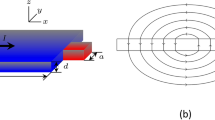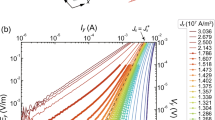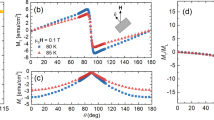Abstract
A new class of artificial atoms, such as synthetic nanocrystals or vortices in superconductors, naturally self-assemble into ordered arrays. This property makes them applicable to the design of novel solids, and devices whose properties often depend on the response of such assemblies to the action of external forces. Here we study the transport properties of a vortex array in the Corbino disk geometry by numerical simulations. In response to an injected current in the superconductor, the global resistance associated to vortex motion exhibits sharp jumps at two threshold current values. The first corresponds to a tearing transition from rigid rotation to plastic flow, due to the reiterative nucleation around the disk centre of neutral dislocation pairs that unbind and glide across the entire disk. After the second jump, we observe a smoother plastic phase proceeding from the coherent glide of a larger number of dislocations arranged into radial grain boundaries.
This is a preview of subscription content, access via your institution
Access options
Subscribe to this journal
Receive 12 print issues and online access
$259.00 per year
only $21.58 per issue
Buy this article
- Purchase on Springer Link
- Instant access to full article PDF
Prices may be subject to local taxes which are calculated during checkout





Similar content being viewed by others
References
Murray, C., Kagan, C. & Bawendi, M. Synthesis and characterization of monodisperse nanocrystals and close-packed nanocrystal assemblies. Annu. Rev. Mater. Sci. 30, 545–610 ( 2000).
Mitchell, T.B., Bollinger, J.J., Itano, W.M. & Dubin, D.H.E. Stick slip dynamics of a stressed ion crystal. Phys. Rev. Lett. 87 183001 ( 2001).
Pertsinidis, A. & Ling, X.S. Diffusion of point defects in two-dimensional colloidal crystals. Nature 413, 47–50 ( 2001).
Brandt, E.H. The flux-line lattice in type two superconductors. Rep. Prog. Phys. 58, 1465–1594 ( 1995).
Abrikosov, A.A. On the magnetic properties of superconductors of the second kind. Sov. Phys. JEPT 5, 1174–1182 ( 1957).
Safar, H. et al. Experimental evidence for a first-order vortex-lattice-melting transition in untwinned, single crystal YBa2Cu3O7 . Phys. Rev. Lett. 69, 824–827 ( 1992).
Avraham, N. et al. Inverse melting of a vortex lattice. Nature 411, 451–454 ( 2001).
Bouquet, F. et al. An unusual phase transition to a second liquid vortex phase in the superconductor YBa2Cu3O7 . Nature 411, 448–451 ( 2001).
Schilling, A., Welp, U., Kwok, W.K. & Crabtree, G.W. Vortex-lattice melting in untwinned YBa2Cu3O7-δ for H⊥c. Phys. Rev. B 65, 054505 ( 2002).
Fisher, D.S., Fisher, M.P.A. & Huse, D. Thermal fluctuations, quenched disorder, phase transitions, and transport in type II superconductors. Phys. Rev. B 43, 130–159 ( 1991).
Nelson, D.R. & Vinokur, V.M. Bose glass scaling for superconducting vortex arrays revisited. Phys. Rev. B 61, 5917–5919 ( 2000).
Giamarchi, T. & Le Doussal, P. Elastic theory of flux lattices in the presence of weak disorder. Phys. Rev. B 52, 1242–1270 ( 1995).
Klein, T. et al. A Bragg glass phase in the vortex lattice of a type II superconductor. Nature 413, 404–406 ( 2001).
Giamarchi, T. & Le Doussal, P. Moving glass theory of driven lattices with disorder. Phys. Rev. B 57, 11356–11403 ( 1998).
Crabtree, G.W., Lopez, D., Kwok, W.K., Safar, H. & Paulius, L.M. Dynamic correlation in driven vortex phases. J. Low Temp. Phys. 117, 1313–1322 ( 1999).
Bhattacharya, S. & Higgins, M.J. Dynamics of a disordered flux line lattice. Phys. Rev. Lett. 70, 2617–2620 ( 1993).
Marchevsky, M., Aarts, J., Kes, P.H., & Indenbom, M.V. Observation of the correlated vortex flow in NbSe2 with magnetic decoration. Phys. Rev. Lett. 78, 531–534 ( 1997).
Paltiel, Y. et al. Dynamic instabilities and memory effects in vortex matter. Nature 403, 398–401 ( 2000).
Paltiel, Y. et al. Instabilities and disorder-driven first-order transition of the vortex lattice. Phys. Rev. Lett. 85, 3712–3715 ( 2000).
D'Anna, G. et al. Evidence of surface superconductivity in 2H-NbSe2 single crystals. Phys. Rev. B 54, 6583–6586 ( 1996).
López, D. et al. Spatially resolved dynamic correlation in the vortex state of high temperature superconductors. Phys. Rev. Lett. 82, 1277–1280 ( 1999).
Marchetti, M.C. & Nelson, D.R. Vortex physics in confined geometries. Physica C 330, 105–129 ( 2000).
Benetatos, P. & Marchetti, M.C. Plasticity in current-driven vortex lattices. Phys. Rev. B 65, 134517 ( 2002).
Jensen, H.J., Brass, A. & Berlinsky, A.J. Lattice deformations and plastic flow through bottlenecks in a two-dimensional model for flux pinning in type-II superconductors. Phys. Rev. Lett. 60, 1676–1679 ( 1988).
Fangohr, H., Cox, S.J. & de Groot, P.A.J. Vortex dynamics in two-dimensional systems at high driving forces. Phys. Rev. B 64, 064505 ( 2001).
Chen, Q.-H. & Hu, X. Nonequilibrium phase transitions of vortex matter in three-dimensional layered superconductors. Phys. Rev. Lett. 90, 117005 ( 2003).
Miguel, M.-C., Vespignani, A., Zapperi, S., Weiss, J. & Grasso, J.R. Intermittent dislocation flow in viscoplastic deformation. Nature 410, 667–671 ( 2001).
Hirth, J.P. & Lothe, J. Theory of Dislocations (Krieger, Malabar, Florida, 1992).
Miguel, M.-C. & Kardar, M. Elasticity and melting of vortex crystals in anisotropic superconductors: Beyond the continuum regime. Phys. Rev. B 62, 5942–5956 ( 2000).
de Gennes, P.-G. Superconductivity of Metals and Alloys (Benjamin, New York, 1966).
Chaikin, P.M. & Lubensky, T.C. Principles of Condensed Matter Physics (Cambridge Univ. Press, Cambridge, 1995).
Veje, C.T., Howell, D.W. & Behringer, R.P. Kinematics of a two-dimensional granular Couette experiment at the transition to shearing. Phys. Rev. E 59 739–745 ( 1999).
Acknowledgements
We thank G. Jung, M. Zaiser, R. Pastor-Satorras, and J. S. Andrade Jr. for useful remarks. This work is supported by an Italy–Spain Integrated Action. M.C.M. is supported by the Ministerio de Ciencia y Tecnología (Spain).
Author information
Authors and Affiliations
Corresponding author
Ethics declarations
Competing interests
The authors declare no competing financial interests.
Supplementary information
Supplementary Information, Fig. S1
Supplementary Information, Fig. S2 (PDF 234 kb)
41563_2003_BFnmat909_MOESM2_ESM.gif
Supplementary Information, Movie 1The onset of plastic flow (I =0.04) in a system of radius D = 18 with N = 1032 vortices. (GIF 1230 kb)
41563_2003_BFnmat909_MOESM3_ESM.gif
Supplementary Information, Movie 2The onset of plastic flow (I = 0.04) in a system of radius D = 36 with N = 1032 vortices. (GIF 1246 kb)
41563_2003_BFnmat909_MOESM4_ESM.gif
Supplementary Information, Movie 3The laminar phase (I = 0.3) when defects are arranged into grain boundaries, in a system of radius D = 18 with N = 1-32 vortices. (GIF 1422 kb)
41563_2003_BFnmat909_MOESM5_ESM.gif
Supplementary Information, Movie 4The laminar phase (I = 0.3) when defects are arranged into grain boundaries, in a system of radius D = 36 with N = 2064 vortices. (GIF 1775 kb)
41563_2003_BFnmat909_MOESM6_ESM.gif
Supplementary Information, Movie 5The first transient steps before reaching the laminar phase corresponding (I = 0.3) in a system of radius D = 36 with N = 2064 vortices. In this animation each snapshot is separated by dt = 3 timesteps and the sequence is cycled. (GIF 1396 kb)
Rights and permissions
About this article
Cite this article
Miguel, MC., Zapperi, S. Tearing transition and plastic flow in superconducting thin films. Nature Mater 2, 477–481 (2003). https://doi.org/10.1038/nmat909
Received:
Accepted:
Published:
Issue Date:
DOI: https://doi.org/10.1038/nmat909
This article is cited by
-
Evidence of second-order transition and critical scaling for the dynamical ordering transition in current-driven vortices
Scientific Reports (2024)
-
How the vortex lattice of a superconductor becomes disordered: a study by scanning tunneling spectroscopy
Scientific Reports (2015)
-
The mysteries of plastic motion
Nature Materials (2003)



